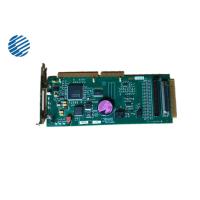ADVANTAGES OF AUTOMATED DEPOSIT AND BANKNOTE RECYCLING The HT-2845 ATM has the following advantages:
(1) Automated deposit function
With the automated deposit function, the HT-2845 ATM can adjust account information immediately after the deposit transaction. This function eliminates the need for the bank staff to count and record the deposited banknotes in the back office.
(2) Banknote recycling system
The banknote recycling system can divert deposited banknotes into use for subsequent withdrawal transactions, storing banknotes in the same place for both deposit and withdrawal (see Fig. 2).
This system reduces the required space for storing cash needed for withdrawal, and banks can release their funds for alternative use.
Banks can also reduce ATM running costs, because frequent cash replenishment is not needed.
HITACHI’S NEW CASH MODULE
This chapter describes Hitachi’s new Cash Module (HCM), HT-3842, which enables the HT-2845 ATM to have the features described above (Fig. 3). Configuration and Actions The HT-3842 HCM is divided into an upper and a lower unit (see Fig. 4).
The upper unit is a note-recognition unit consisting of a cash in and out slot, a bill validator, a temporary stacker, and note-transport mechanisms. The lower unit is a banknote storage and it can be installed in a security safe. The lower unit can be equipped with up to five cassettes.
Communicating with the ATM, the HT-3842 HCM processes banknotes as follows: (1) It counts and validates the banknotes deposited by
a customer and sends them to the temporary stacker (escrow). (2) It sends banknotes from the temporary stacker and stacks them in the cassettes. (3) It dispenses banknotes from the cassettes and sends them to the cash in/out slot, validating each banknote in the process. Key Mechanisms The HT-3842 HCM has the following key mechanisms for the excellent performance of its functions.
(1) Cash in and out slot A single cash slot can handle bulk notes for both deposit and withdrawal transactions. This enables simple and easy operation for ATM users. Notes in bad condition are detected by a sensing system and returned immediately. The distance between banknotes fed into the system is strictly controlled. The controlling system with paddle-roller rotation enables stacking banknotes of various sizes in good condition. These mechanisms prevent the jamming of banknotes. (2) Banknote transport mechanism A simple two-way mechanical configuration provides high transport reliability. Using highly flexible and low-load durable transport belts, HCM can process banknotes at a speed of approximately 8 notes a second, which is the highest speed for banknote recycling modules handling world currencies. Optical sensors along the path are tuned automatically to prevent sensing troubles caused by dust. (3) Temporary stacker (escrow) The temporary stacker has a dram wheel that rolls up and winds off banknotes in the deposit process.
This mechanism enables handling banknotes of various sizes and those in bad condition. (4) Cassettes
The cassettes can hold a large number of banknotes, by stacking banknotes vertically and lining them up horizontally. ROLLING OUT INTO THE WORLD MARKET In 2000, Hitachi participated in CIFTEE (China International Exhibition on Financial Technology and Equipment) in Beijing to demonstrate its HT-2845 ATM, which was approved by Chinese government leaders and bank executives. In March, 2001, the ATM began its operation in China, and so far about 100 ATMs with cash recycling are in use. Hitachi is now providing its cash-handling module, HT-3842 HCM,to global ATM manufacturers. Some manufacturers have already exhibited their original cash-recycling ATM integrating HT-3842 (Retail Delivery Show, U.S.A., January 2000; CeBIT, Germany, March 2001).







